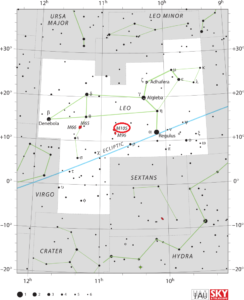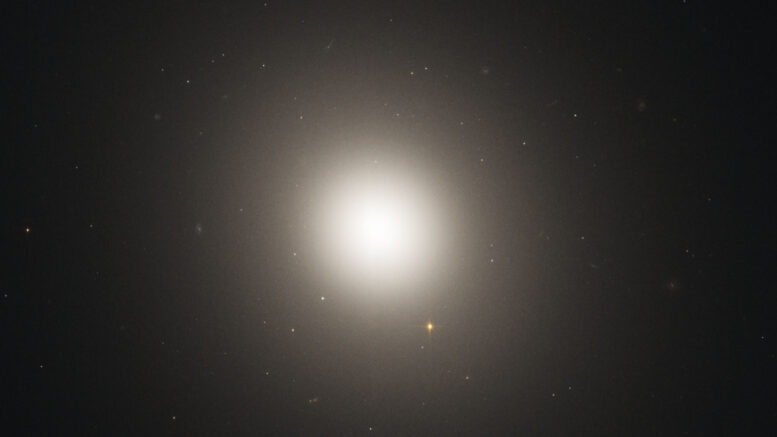Messier 105 is a member of the M96 Group, Leo I Group, a group of galaxies that also includes Messier 95, Messier 96, and at least 21 fainter members. M105 is the brightest elliptical galaxy in the group.
Messier 105 and its companion NGC 3384 are surrounded by a vast ring of neutral hydrogen gas. The ring has a radius of 650,000 light years and is a site where star forming activity has been detected.
| Description | |
| Visible From Pacific Northwest | March through May |
| Best Time To Observe | April |
| Minimum Size Of Viewing Device | Small Telescope |
| Object Type | Elliptical Galaxy |
| Designations | Messier 105, M105, NGC 3379, PGC 32256, UGC 5902, 2MASX J10474959+1234538, MCG+02-28-011, GIN 773, K79 33A, Z 66-18, Z 1045.2+1251, UZC J104749.6+123453 |
| Right Ascension | 10h 47m 49.6s |
| Declination | +12°34’54” |
| Constellation | Leo |
| Number Of Stars | 40 Billion |
| Apparent magnitude | +10.2 |
| Apparent dimensions | 5′.4 x 4′.8 |
| Object Radius | 27,000 light years |
| Distance From Earth | 32,000,000 light years |
History
Messier 105 was discovered by Charles Messier’s colleague Pierre Méchain on March 24, 1781, only days after he had found the nearby galaxies M95 and M96. M105 was not included in the original Messier Catalogue, but only added to it in 1947 along with M106 and M107, after American-born Canadian astronomer Helen Sawyer Hogg had discovered Méchain’s letter with a description of the object, identified as the galaxy NGC 3379. Méchain’s letter to Johann Bernoulli, dated May 6, 1783, included description of M105.
Interestingly, Méchain discovered M105 a few days before finding Messier 101 the Pinwheel Galaxy, but M105 was not included in Messier’s final published edition of the catalogue.
William Herschel discovered M105 independently on March 11, 1784 and catalogued it as H I.17.
John Herschel catalogued it as h 757 and later included the object in his General Catalogue as GC 2203. He described it as “very bright; considerably large; round; pretty suddenly brighter toward the middle; mottled.”
Locating M105 In The Sky
Messier 105 can be found along the line from Regulus, the brightest star in Leo, to Denebola, which lies 24 degrees east and a little north of Regulus. The galaxies M95 and M96 are also located in this region of the sky. M105 is the northernmost member of the group. M96, the brightest of the three galaxies, is positioned 50 arc minutes south of M105 and M95 lies 40 arc minutes west of M96. The best time of year to observe the galaxies is during the spring.

Viewing M105
The galaxy is difficult to see in small binoculars and easier to find in large binoculars and small telescopes. 3-inch telescopes show a small, round faint patch of light, while 8-inch telescopes reveal a larger object, but do not show more detail. Like any elliptical galaxy, M105 is not particularly impressive to observe because details of its structure cannot be made out in any kind of telescope. 10-inch telescopes will reveal two neighbouring galaxies, NGC 3384 and NGC 3389, in the same field of view.
Photographing M105
Imaging Messier 105 is tough, as the guides available mostly are those who are imaging Messier 95 and Messier 96, and then take an image of Messier 105 as a ball of light. This lacks detail on Messier 105 and is tough to find a good resource to provide for those looking to image Messier 105.
Sources And Further Reading
Descriptions of all of Messier Objects can be found here.
https://www.nasa.gov/feature/goddard/2017/messier-105
https://www.messier.seds.org/m/m105.html
https://freestarcharts.com/messier-105
https://www.cloudynights.com/gallery/image/24556-m96-m95-m105/

Be the first to comment on "Messier 105"